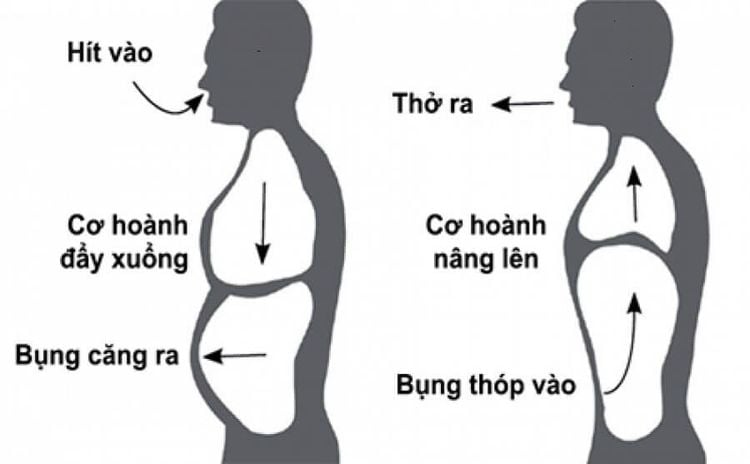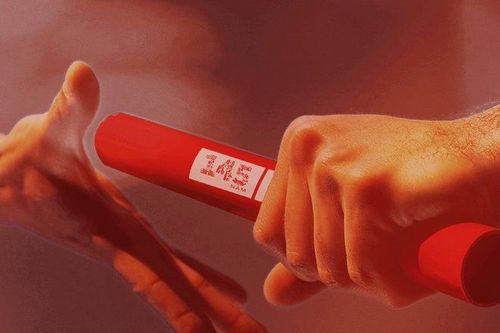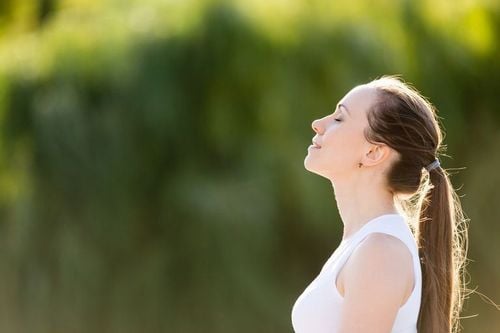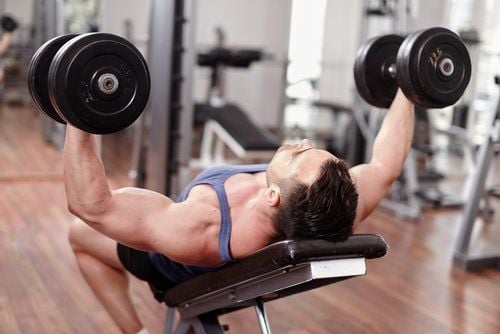This is an automatically translated article.
Breathing through your diaphragm, or breathing deeply from your diaphragm rather than your chest, is a way to relax and reduce anxiety. Although we are all capable of breathing in this way, very few do so in everyday life. So how to take a deep breath? Check out the content below to learn more.
1. What are the effects of deep breathing?
Deep breathing is called belly breathing or belly breathing. It involves inhaling slowly and deeply through the nose, filling the lungs with air as the abdomen expands.
The effects of deep breathing include:
Your muscles are relaxed: Because deep breathing promotes core muscle stability and helps you endure better during intense exercise. It may even help relieve symptoms of post-traumatic stress disorder (PTSD). Improved oxygen supply: When you breathe deeply and feel relaxed, oxygen flows into every cell in your body. This increases the function of every system in the body. You will feel your focus and physical endurance improve. Your blood pressure drops: When your muscles relax, your blood vessels dilate and your blood pressure can return to normal. Endorphins Released: Deep breathing stimulates the release of endorphins, which improve stress response and reduce pain. With the stress response, the body's sympathetic nervous system alerts nerve pathways to activate the adrenal glands, which then release adrenaline into the bloodstream. This burst of adrenaline raises your blood pressure and pulse rate and can cause you to exhale short, shallow breaths from your chest. By breathing deeply from your diaphragm, you activate your body's parasympathetic nervous system. This system reverses the stress response by slowing the heart rate, lowering blood pressure, and calming the mind. With deep breathing, you can trigger your body's relaxation response, a state of profound calm. Improve detoxification: Good breathing habits help the lymphatic system to function properly, encouraging the elimination of harmful toxins. This cleanses the body and allows it to direct its energy to more efficient functions.

Hít thở sâu mang lại rất nhiều lợi ích
2. Factors affecting deep breathing
Breathing rate can vary with age, weight, exercise tolerance and general health. For adults, the normal breathing rate is between 14 - 20 breaths per minute. However, several factors can decrease respiratory function, producing a shallow tachypnea pattern.
Sudden or chronic pain can activate a part of the nervous system that governs many of your body systems, including your breathing rate, heat rate, and body temperature. Chronic stress and strong emotions such as anger or fear will increase your fight-or-flight response, which can decrease your breathing rate.
Poor posture also contributes to your breathing dysfunction. This is common in people who sit for long hours each day. Rounded shoulders and a forward-facing head position tense the muscles around the chest. That squeeze limits the rib cage's ability to expand and makes people breathe faster and shallower.
3. How to take a deep breath?
Although these benefits are widely known, the hectic pace of life combined with a sedentary work environment has resulted in many of us taking only quick, shallow breaths. Over time, this weakens the strength of our respiratory muscles. It also creates stress in the upper body, which can alter our posture and undermine our health.
So how to be able to breathe properly?
It is important to practice deep breathing techniques in a positive state so that your body can easily experience the benefits. For example, you may not be able to practice deep breathing properly and consciously while you're sleeping, or when you're lounging on the sofa watching TV. Make sure to sit up straight or lie flat so your diaphragm doesn't contract and you can't inhale and exhale fully.
Even just a few minutes of deep breathing daily can help you reduce stress, improve lung function and experience other health benefits. Start with about five minutes a day and work your way up to 20 or 30 minutes for optimal results. With practice, your body can more easily switch to deep breathing than to a stress response.
Take the steps below to learn how to relieve your stress:
Find a comfortable, quiet place to sit or lie down. Choose a place where you know you won't be disturbed. If sitting, keep your back straight and your feet flat on the floor. Close your eyes. Place one hand on your belly and just below your ribs. Place your other hand on your chest. Breathe steadily. Now take slow, deep breaths. Inhale slowly through your nose. Notice when your belly bulges under your hand. Hold your breath, pause for a second or two. Slowly exhale through your mouth. Pay attention when placing your hand on your stomach according to the rhythm of your breathing. Do this a few times until you have a soothing rhythm. You should add “image” to your breathing. As you inhale, imagine that the air you are breathing is spreading relaxation and calm throughout your body. As you exhale, imagine that your breath is dispelling stress and fatigue. Try to breathe deeply for 10 minutes or until you feel relaxed and less stressed. Gradually work your way up to 15-20 minutes. * Deep breathing techniques you should know:
There are different techniques you can try to breathe deeply from your belly instead of your chest. Try different exercises to see which gives you the most sense of calm.
To breathe with your diaphragm or belly, sit down or lie flat on your back. Then place one hand on your stomach and one on your chest. Inhale slowly through your nose and let your belly expand, making sure your chest doesn't move. Exhale slowly through slightly parted lips, as if you were whistling. Use your hands to push all the air out of your belly and repeat the exercise three or more times. The 4-7-8 breathing techniques are similar to belly breathing. Simply do the exercise above in the same way, but add in the count. As you inhale, count to four, and then hold your breath for a count of seven. Exhale for a count of eight, then push all the air out of your stomach with your hands. Repeat as desired. Ujjayi Breathing Technique: An exercise commonly used in yoga classes to generate heat inside the body and help calm the mind. Start in a cross-legged position, relax, and inhale through your nose slowly and gently as if you were "sipping air through a straw". Slightly constrict the opening of the throat so that as you exhale there will be some resistance as you push the air out.

Thực hành các kỹ thuật thở sâu trong trạng thái tích cực để cơ thể bạn có thể dễ dàng trải nghiệm những lợi ích
4. Tips to get all the benefits of deep breathing
If you can't make time just to breathe deeply, then consciously try to breathe more deeply in your daily life, with particular emphasis on complete exhalation, this is an important part of breathing properly. Place your hand on your stomach to feel the path of your breath throughout the exercise. Your abdomen will rise and fall considerably while breathing. Some people find that white noise, relaxing music, or the sound of rain are soothing and help them relax to practice deep breathing. Others find these distracting and prefer quiet. Do some experimenting to find out what relaxes you and works for you.
Please dial HOTLINE for more information or register for an appointment HERE. Download MyVinmec app to make appointments faster and to manage your bookings easily.
References: webmd.com, healthline.com, livingthenourishedlife.com













